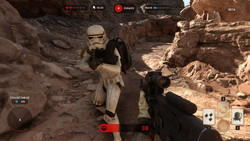Star Wars Battlefront Beta Notebook and PC Benchmarks
Also see our benchmark article on the final version of Star Wars Battlefront with lots of laptop and PC benchmarks.
For the original German article, see here.
For Battlefront, Dice employs the improved Frostbite 3 engine, known by many for its implementation in Battlefield 4 and Hardline. The few maps in the beta version have very appealing graphics. Photorealistic textures, excellent lighting effects, and - thanks to tessellation - lots of geometric detail, give rise to a fantastic atmosphere. The beta version proved to be pleasantly stable in our tests. The game only failed to start when we tried to run it on an outdated Intel graphics driver, and even in that case it warned us preemptively of this issue. The game neither crashed nor generated any serious graphics errors in our tests.
At the lowest detail setting, the graphics deteriorate markedly - too much frugality with the system resources robs the visuals of their magic. Gamers will encounter limitations at the lowest resolution setting as well (1024x768). Some texts are very difficult to read at such a low pixel count. Starting at the medium detail setting and 1366x768, Battlefront begins to look impressive. Even so, the step up to high details constitutes an unmistakable transformation.
Benchmark
As our benchmark sequence, we used the only single-player mission available in beta. The survival mission on Tatooine sends us in waves against the Imperial stormtroopers. We used Fraps to record the average frame rate during at least one wave of attack. In our tests, these results were very comparable to the average performance results in multiplayer duels on the two Beta maps. However, because the test sequence can't be perfectly standardized, there is a certain degree of imprecision inherent in comparing graphics cards. Nevertheless, over the course of several test runs, most graphics cards achieved relatively consistent results (only diverging by 1 fps or less).
Results
Star Wars Battlefront is reasonable with its hardware demands. Even the Intel HD Graphics 5500 in the Broadwell Core i3-5010U (Intel NUC 5i3RYK) is able to render the game fluidly at the lowest graphics settings. The AMD FX-7500 with an integrated Radeon R7, which is faster on average, is the only card that dropped frames. The Intel Iris Pro 5200 (in the Schenker S413) ran at a similar speed at medium settings and played smoothly in single-player mode. For multiplayer battles, on the other hand, 40 fps should be the absolute minimum, otherwise there won't be enough performance reserves for the more hectic scenes. That means only stronger dedicated notebook graphics cards are on the table here - like the Radeon R9 M280X for medium detail settings. Current Nvidia GTX graphics cards, like the GTX 960M and above, are able to provide more performance (as they just proved in our Battlefield tests). These potent cards should offer sufficient computational power for the high detail preset.
In order to play Battlefront at the highest detail setting - "Ultra" - you’ll need at least a GeForce GTX 970M or Radeon R7 370 desktop graphics card. The latter reached about 48 frames per second in Full HD (1920x1080). For 4K, only a high-end desktop graphics card will make the cut. Our Radeon R9 290X rendered a playable 36.4 fps on average, delineating the lower performance limit for this high resolution. The GeForce GTX 980Ti or Radeon R9 Fury X, on the other hand, should provide plenty of computational oomph for this game.
Overall, the beta version of Battlefront made a very good impression on us. The graphics and performance are great. However, the limited choice of maps and gaming modes makes it impossible to judge the title's ability to keep a gamer interested in the long-term.
We plan to publish further benchmarks and impressions of the game when the final version of Star Wars Battlefront is released - stay tuned!
Test Systems
Our four test devices are courtesy of Schenker Technologies (mysn.de):
- W504 (Core i7-4700MQ, 8 GB DDR3, GeForce GTX 860M, GTX 870M, GTX 880M, GTX 970M, GTX 980M)
- A505 (Core i7-4720HQ, 8 GB DDR3, GeForce GTX 960M)
- M504 (Core i5-4340M, 8 GB DDR3, GeForce GTX 850M)
- M503 (Core i7-4702MQ, 8 GB DDR3, GeForce GT 750M)
Three notebooks were provided by Nvidia:
- HP Envy 15-j011sg (Core i5-4200M, 12 GB DDR3, GeForce GT 740M)
- MSI CX61-i572M281BW7 (Core i5-4200M, 8 GB DDR3, GeForce GT 720M)
- Acer Aspire Timeline Ultra M3-581TG (Core i7-2637M, 4GB DDR3, GeForce GT 640M)
Intel also supplied us one:
- Schenker S413 (Core i7-4750HQ, 8 GB DDR3, Iris Pro Graphics 5200)
- NUC 5i3RYK
The desktop computers contain CPUs/APUs from Intel and AMD, SSDs from Micron, Intel and Samsung, motherboards from Intel and Asus, and graphics cards from Nvidia and AMD. We use the Asus PB287Q as our 4K monitor.











